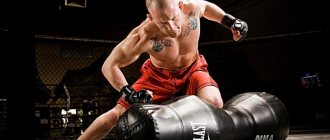Share:
Nutrition in the development of strength and endurance of a crossfitter is no less important than the training itself. Both the quality and composition of products and the mode of eating are important. Therefore, many novice athletes, having decided to switch to a healthy diet, are puzzled by whether they can eat before training, how many hours in advance and what to eat before training, depending on your goals - losing weight or gaining muscle mass. In this article, we have tried to answer all of these important questions to help new CrossFitters resolve the dilemma of whether it is okay to eat before a workout.
It should be said right away that the answer to none of the above questions will be unambiguous, since it all depends on what specific goal a particular training athlete is pursuing:
- If the goal of training is to lose weight, then you should eat at least 2-2.5 hours before training. At the same time, the amount of carbohydrates in food should be kept to a minimum - no more than 15-20 grams per serving. Otherwise, during training, the body will begin to waste food energy, rather than the energy of its own fat reserves. On the contrary, the amount of protein needs to be increased - about 20-30 grams per serving. In this case, protein is needed to provide the muscles with a complete set of amino acids before starting a workout.
- Fats in a pre-workout diet for weight loss are extremely undesirable. They can significantly slow down the absorption of other nutrients from food and cause nausea during strenuous exercise. In any case, before exercising to lose weight, you should not feel heavy in your stomach, but the feeling of hunger should not interfere with exercise.
- If the goal of training is to gain muscle mass, then food intake should be made more substantial 1-1.5 hours before the start of training. A serving of food should contain healthy complex carbohydrates and proteins, the amount of fat in a given meal should be limited - no more than 5 grams.
- Eating carbohydrates before a workout aimed at building muscle mass will ensure that glycogen stores are loaded. As a result, the energy potential of the muscles will increase, the overall endurance and performance of the body during training will increase. Protein before training supplies muscles with amino acids and triggers anabolic activity.
What to eat to gain muscle mass?
Now that we have a general idea of what you can eat before exercise, it’s worth taking a closer look at which foods will be beneficial before physical activity, and which should be excluded from an athlete’s diet.
When considering the benefits of consuming certain foods before training, we must not forget about what goal a particular athlete is pursuing. If the goal of training is to gain muscle mass, then the quantity and quality of food before exercise is of paramount importance.
A pre-workout meal aimed at gaining muscle mass should consist of a portion of high-quality protein (at least 20-30 grams) and complex carbohydrates (50-60 grams). Depending on your preferences, you can choose one of the proposed dish options:
- a small piece of chicken (or turkey) with pasta made from durum flour (the side dish can be replaced with brown rice or grain bread);
- a piece of lean fish with potatoes (or brown rice);
- lean beef steak with durum pasta or buckwheat;
- omelette of 3-4 eggs with buckwheat (or other porridge);
- a portion of cottage cheese with wholemeal bread (you can add some fresh berries and a couple of teaspoons of honey to the cottage cheese).
Banana ice cream
Ingredients:
- ripe bananas
- everything else is optional.
Peel and cut each banana into 3-4 pieces, then leave it in the freezer for at least two hours. Take out the woody fruit and puree it with a blender until smooth.
You can add any topping to the banana base. For example: add 1-2 tablespoons of peanut butter and a little milk to one frozen banana to improve the consistency.
Another win-win option is to add coconut milk and sweetener to the banana mixture. You can use agave syrup, dried fruits, or stevia as a sweetener, but if the banana is ripe, it’s still sweet.
100 g contains: Kcal 89 | Proteins 1.5 g | Fat 0.1 g | Carbohydrates 21.8 g + filler calories.
What to eat to lose weight?
If the goal of training is weight loss, then the list of foods allowed for consumption before training should be reduced. You especially need to remember the “golden rule” of losing weight: calorie consumption should exceed their intake into the body. The pre-workout diet of an athlete who wants to lose weight should not contain high-calorie foods: simple carbohydrates and excess fat. It is allowed to consume only small amounts of complex carbohydrates (no more than 15-20 grams per serving), as well as a sufficient amount of protein (about 20-30 grams per serving). At your own discretion, you can choose one of the proposed dish options:
- A small piece of chicken baked in the oven with buckwheat or wild rice;
- A small portion of white lean fish, steamed with brown rice;
- 2-3 poached eggs or omelet of 2 eggs with cottage cheese and herbs;
- Small veal steak with baked jacket potatoes.
Eating food before training should not interfere with full-fledged exercise, so it is advisable to eat at least 1.5-2 hours before physical activity. However, do not neglect eating before training, since without nutrition you will not be able to train intensely and effectively.
Sports nutrition before physical activity
The appearance of sports nutrition on the market created a real sensation. All kinds of dietary supplements and other additives have faded into the background. All the attention of novice athletes was focused on advertising for sports nutrition, where already titled athletes attracted potential buyers with their sculpted bodies, casually mixing the next protein shake in a fashionable shaker. Little by little, the strong connection between a beautiful body and sports nutrition has taken root in the minds of novice athletes.
But in reality everything is different. The role of sports nutrition in building muscle mass is greatly overestimated. Drinking a protein shake before training can only be justified if you do not have the opportunity to have a full meal before training.
Protein and gainer
Therefore, if you do not have time for a full meal 1.5-2 hours before training, it is recommended to consume 20-30 grams of whey protein or a similar amount of gainer (if the goal of training is to gain muscle mass and not lose weight) 1 hour before the start workout.
Amino acids
If the main goal is to gain muscle mass, it is recommended to consume a small amount of BCAA amino acids (10-15 grams) immediately before starting a workout. However, recently the use of BCAA has been questioned in scientific circles, as numerous studies indicate the sufficiency of amino acids in the daily diet of the average athlete. Scientists consider the use of BCAA justified only in cases of insufficient intake of amino acids from food, for example, with a low-calorie diet.
Fat burning complexes
If the main goal is weight loss, then it is possible to use a special fat-burning complex before training (about 30 minutes before the start of training). But when using such fat burners, all sorts of side effects may occur, so it is better to discuss the use of such supplements with a specialist.
L-carnitine
A more preferred and widely used sports supplement for weight loss is L-carnitine. You need to take L-carnitine 30 minutes before training. The mechanism of action of L-carnitine on the body is very different from the effect of fat-burning supplements. L-carnitine helps transport fat cells to the place of their disposal - the mitochondria of muscle fibers, but by itself does not have fat-burning properties. Therefore, one intake of L-carnitine to trigger the mechanism of burning fat reserves is not enough; intense aerobic activity is needed during training. Unfortunately, in many cases, taking L-carnitine is useless without aerobic exercise. However, this sports supplement has no side effects and has a beneficial effect on the cardiovascular system.
We should not forget that sports nutrition is just an additive to the athlete’s main diet and cannot replace a complete daily diet.
How to eat ice cream correctly
“The ice cream should melt because the throat has “local immunity,” says the specialist. — If the throat is overcooled, viruses and bacteria will develop, which can even cause a sore throat. Plus, melted ice cream tastes better. It’s better to bite into small pieces, heat and swallow.”
You should not eat ice cream in the evening. The fact is that glucose is processed by insulin and goes into muscle glycogen - our main fuel. Excess glycogen enters the liver and is converted into fat.
It is also not recommended to eat ice cream on an empty stomach: the sugar level instantly jumps, a large amount of excess insulin is produced, which is stored as fat.
shutterstock.com
How many hours before the start of classes can I eat?
As mentioned above, eating should be done at least 1.5-2 hours before the start of the workout. In some cases, when an athlete's metabolism is slow, food should be taken 3 hours before the start of training. In any case, before starting your workout you should feel light and your stomach should not be full. Otherwise, all the blood in the body will accumulate in the stomach area, and energy will be spent on digesting food, and the body’s resources will simply not be enough for effective physical activity.
Digestion time of food
The question of how long before training you should eat is closely related to the time it takes for food to be digested in the body.
The food we prepare for consumption cannot be digested unchanged. In order for food to be digested and used for construction needs and energy costs, the body needs to spend a sufficient amount of time and effort. With the help of the digestion process, the human body is able to obtain building protein from amino acids of digested food, fat from fatty acids and glycerol, and the body transforms glucose into energy and stores it in the liver in the form of glycogen.
Digestion of food in the human body occurs under the influence of many factors. The chemical composition of the food consumed, the type and duration of cooking, the amount eaten, diet, state of the gastrointestinal tract - all this affects the degree of digestibility and time of digestion of food.
The influence of heat treatment on the digestibility of products
So, how does heat treatment of food affect the rate at which it is absorbed by the body? Here's some important information for you:
- The digestibility of protein increases significantly when it is heated, as partial destruction of the structures of the protein molecule occurs (denaturation), which in turn leads to better breakdown of proteins by gastric enzymes.
- When animal fat is heated, its energy value is partially lost as it is rendered out of the product. When cooking fatty meat, more than 45% of the fat goes into the broth.
- Vegetable fat also undergoes chemical changes when heated. When deep-frying foods, thermal oxidation of vegetable oil occurs, and toxic compounds settle on the surface of the fried food.
- Heat treatment of potatoes helps convert the protopectin contained in it into a more digestible form - pectin. Excessive acidity can interfere with this process, so sauerkraut or other acidic product should be added to the soup after the potatoes have already been cooked.
- Raw starch cannot be absorbed by the body at all, so potatoes and Jerusalem artichokes must be subjected to heat treatment.
- Sucrose, contained in fruits and berries, is converted into glucose and fructose under the influence of temperature and acids.
Digestion time for main foods
To make it easier for you to decide which foods and how long before training you can eat, use the table below. It indicates the time it takes for the human stomach to digest certain types of food.
| Product | Digestion time |
| Water | Enters the intestines instantly |
| Fruit and vegetable juices | 10-15 minutes |
| Vegetable broth | 10-15 minutes |
| Fruits and berries that contain a lot of water | About 20 minutes |
| Grapes, orange, grapefruit | 30 minutes |
| Vegetables and salads without adding oil | 35-40 minutes |
| Apples, pears, peaches, bananas | 40 minutes |
| Cabbage, zucchini, corn | 45 minutes |
| Eggs | 45-60 minutes |
| Vegetable salads dressed with oil | 55-60 minutes |
| Fish | 60 minutes |
| Starchy vegetables: potatoes, Jerusalem artichoke | 90-120 minutes |
| Cereal porridges: rice, buckwheat, millet and others | 120 minutes |
| Legumes | 120 minutes |
| Dairy and fermented milk products | 120 minutes |
| Poultry: chicken, turkey | 2.5-3 hours |
| Pumpkin and sunflower seeds | 3 hours |
| Nuts | 3 hours |
| Beef | 4 hours |
| Mutton | 4 hours |
| Pork | 5.5 – 6 hours |
Along with the digestion time of food, a significant factor is the degree of its digestibility. For example, food of animal origin (proteins and fats) is absorbed in the body by approximately 90%. Fiber and food of plant origin are absorbed by the body on average by 60%, if the food is mixed - by 80%.
Egg white is considered to be the standard for food digestibility. It is absorbed in the body by approximately 98%. The high degree of digestion of egg white can be explained by the fact that the egg itself is a single cell and there are no intercellular spaces or connections in its structure. The same cannot be said about meat, since in order to digest meat protein, the body requires additional enzymes to “break” and digest these intercellular connections.
Recipe No. 3. Ice cream with almonds and cocoa
Mix thoroughly in a blender:
- 2 frozen bananas;
- 200 ml. heavy cream;
- 1 tbsp. cocoa powder;
- 1/3 cup almonds;
- sweetener to taste.
The resulting mixture can be consumed either immediately in the form of curd mass, or after placing it in the freezer for 30 minutes and then eating it in the form of ice cream. It is worth noting that cocoa must be used without additives or sugar. Before use, ice cream is additionally decorated with nuts, syrup, cinnamon and chocolate chips.









